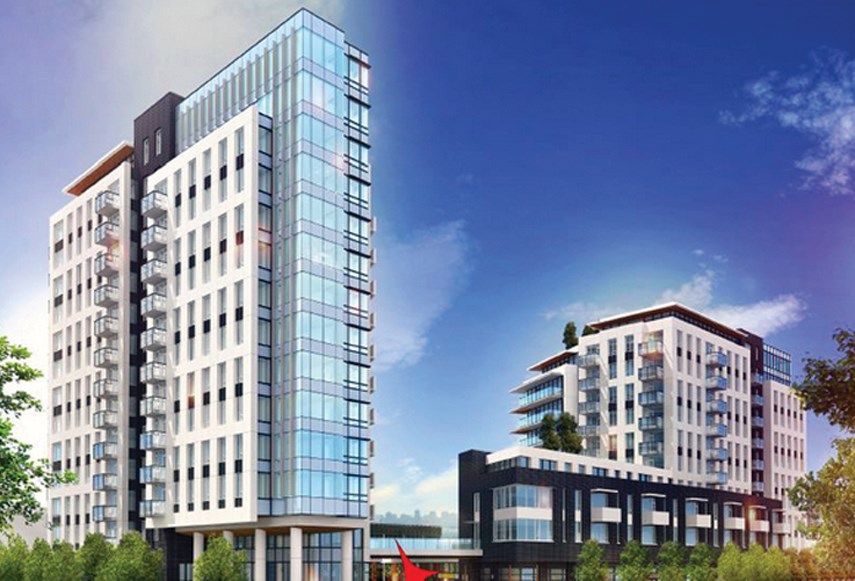This story has been amended since first posting.
Almost six years after it was first proposed, West Vancouver council has approved development of two towers at the former White Spot site at Park Royal.
Council voted 4-3 Monday night in favour of Larco’s proposal for 203 residential units in 11- and 14-storey towers, a daycare facility and 29,000 square feet of the commercial space at 752 Marine Dr.
All of the units will be rentals, 11 of which will be owned by the district to be rented out at affordable rates to people in need of supportive housing. The project includes 179 residential parking spots – 0.88 per unit – all of which will be “decoupled” from the residential units, meaning people who choose to live car free will not be forced to pay for a parking spot. In addition to the supportive housing and child-care space, the district will receive $10.6 million in community amenity contributions.
The proposal is in compliance with the Marine Drive local area plan, which the district passed last year. The project was largely supported at the public hearing, which stretched over two council meetings. Those in favour urged council to vote in the much-needed rental and affordable housing. Those opposed were incredulous council could consider putting more people so close to congested Lions Gate Bridge bottleneck.
Coun. Craig Cameron said he understood the community’s anxiety over traffic but, he added, provincial data shows vehicle crossings over the Lions Gate have been in decline for years. Allowing Larco to develop the land strictly for commercial use would add even more vehicles to the road, Cameron added.
“The only thing that’s going to make the traffic change is behavioural change and that’s things like road pricing, that is things like people deciding to not make trips, or carpool,” he said. “People don’t want to talk about changing their own behaviours. They want everyone else to change their behaviours. It’s just unrealistic to think there’s going to be a big solution here.”
Coun. Mary-Ann Booth focused her comments on the housing affordability crisis, noting the municipality could not retain teachers, mechanics for its bus fleet or police and firefighters with single-family homes selling for $5 million and 0.2 per cent rental vacancy. The alternative is for West Vancouver to become either a ghost town or a resort town for the world’s rich, Booth added.
“I know there is frustration out there around traffic but there is desperation around housing,” she said. “It does come down to what we want this community to look like. I want a community that is inclusive, that is complete, where everyone is welcome, where we have a variation in all demographics. That actually makes for a very vibrant and exciting and healthy place to live.”
Coun. Nora Gambioli said concentrating development on the municipality’s busiest transit route was smart growth, and that the district had a lot to gain over the long term from Larco’s offering.
“Our very dedicated staff have held the applicant’s feet to the fire so to speak very consistently and they have obtained the most benefits that are possible, I believe, for this community from this development.” she said. “Our job is to make decisions for the future for the whole community, and decisions that will continue to have a benefit in 20 or 30 years or more. Decisions based on facts, not popular decisions or expedient decisions prior to elections.”
Not all agreed, however. Couns. Peter Lambur, Christine Cassidy and Bill Soprovich voted against the rezoning. Among their listed reasons: That it was too dense, that it had too many parking spaces, that it was too ugly, that it would have been better situated at Park Royal North, that there were not enough studio apartments or that the rental units were too big, that the child-care space would be better located somewhere away from Park Royal, that the transit system the buildings’ residents would rely on is not up to snuff, that there should be more rental units and more supportive housing units.
“This proposal isn’t bad but it needs more work and we shouldn’t be afraid to try to pursue the elements that might be improved,” Lambur said.
And Soprovich added, there is likely still plenty of growth coming elsewhere in the municipality.
“We have to somewhere along the line make it very apparent to everybody in this community that we do slow, controlled growth,” he said.
Mayor Michael Smith cast the tie-breaking vote, telling his council it was time for West Vancouver, which has had a population in decline, to start accepting any growth at all.
“In West Vancouver, we are far and away, immeasurably, below anybody else when it comes to growth. ... We do have to accept some density in West Vancouver. It doesn’t mean we have to change our way of life or change the nature of the community,” he said. “We have a good project with a lot of rentals, which we badly need, a lot of CACs (community amenity contributions), which we badly need, a lot of tax revenue, which we badly need. I can’t even imagine any reason why we wouldn’t support this.”
Editor’s note: The story has been amended since first posting to clarify that none of the 203 residential units are being offered for sale at this time. The project includes 49 market rental units in perpetuity, 11 non-market rental units owned by the District of West Vancouver, 51 market rental units for 20 years, and 92 market rental units owned by the developer, Larco.



